Menus
- BMW S 1000 RR against Honda Fireblade
- Comparison test athletes part 2
- Technical data BMW S 1000 RR
- Technical data Honda Fireblade
- Measurements
- Brake measurements
- Conclusion
- Price-performance winner: Honda
- Price comparison of the BMW S 1000 RR and Honda Fireblade
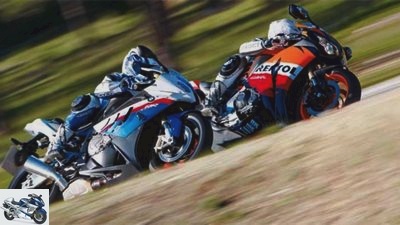
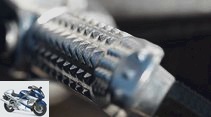
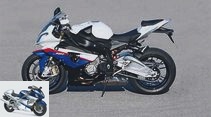
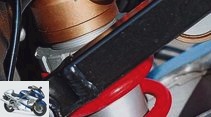
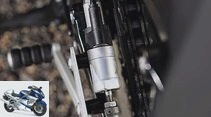
13 photos
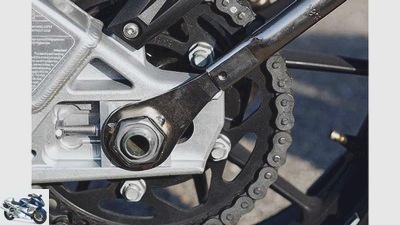
Artist
1/13
The on-board tool kit of the BMW almost ties in with old traditions. With the help of the nine-piece set, you can strip the motorcycle, tension the chain, replace defective lamps and fuses, and adjust the spring preload front and rear.
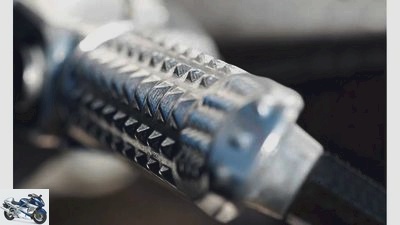
Artist
2/13
The footrests are serrated so that the driver’s boots find a secure hold for all gymnastics exercises that are relevant to fast driving.
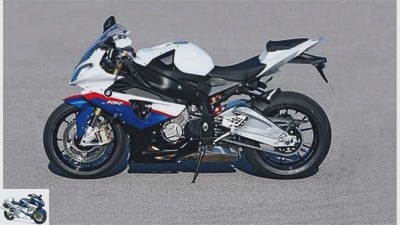
Artist
3/13
A lot of carbon and a delicate shape mean that the S 1000 RR has almost 1 hp per kilogram when fully fueled.
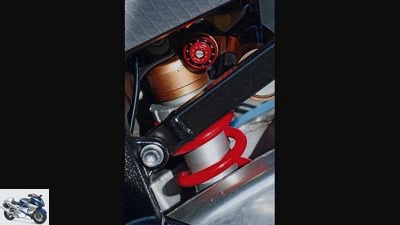
Artist
4/13
The rear compression level can be set in low and high-speed damping.
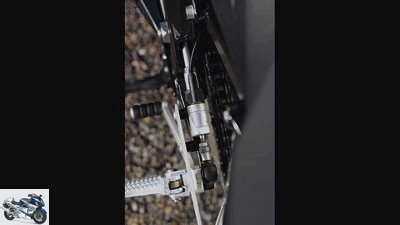
Artist
5/13
Shift up at lightning speed at full throttle: the shift assistant for 360 euros makes it possible.
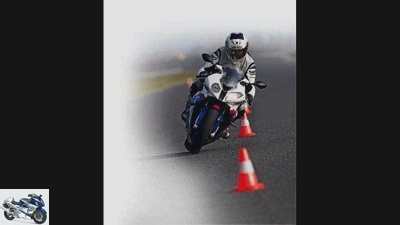
Artist
6/13
Fast as an arrow: the S 1000 RR in the forest of pylons on the top test course.

Artist
7/13
If you want, you can switch off ABS and DTC. The testers didn’t want to, but switched modes more often.
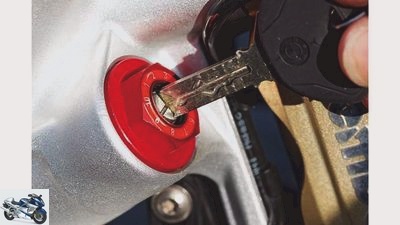
Artist
8/13
The ignition key fits into the heads of the adjusting screws on the fork and the low-speed compression stage of the shock absorber. Most of the damping functions can be quickly adapted to different circumstances.
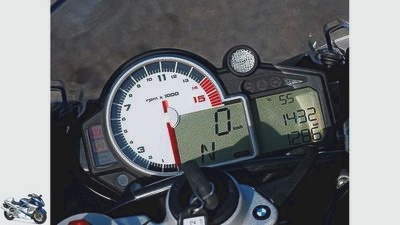
Artist
9/13
What you need: a large rev counter and shift light for the racetrack, useful displays for the country road.
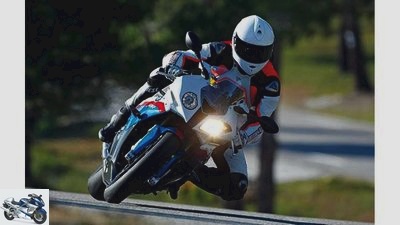
Artist
10/13
The S 1000 is characterized by pleasant handling, high driving stability and steering precision.
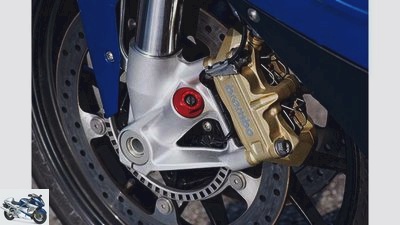
Artist
11/13
The radially screwed Brembo pliers are not monoblocs, but they bite powerfully and easily.
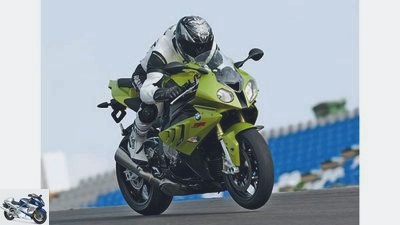
BMW
12/13
The prevention of violent wheelies or stoppies, also a function of the DTC, happens independently of the gyro sensors.
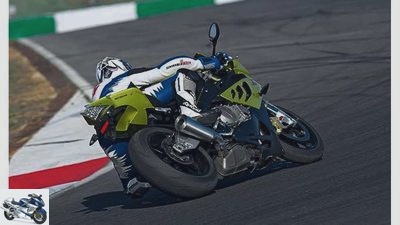
BMW
13/13
Lean and fire free. Everything else is done by the DTC. You just shouldn’t fall over the front wheel when entering the corner.
Comparative test athletes, BMW S 1000 RR, Honda Fireblade
BMW S 1000 RR against Honda Fireblade
Honda deserves the credit for making ABS socially acceptable in the world of athletes. Now BMW is following suit with the S 1000 RR and not only adds traction control, but also an enormous amount of power.
An orange-colored enduro sweeps through the countryside in southern France with a hearty blast. When their pilot sees the MOTORRAD test team on the side of the road, he throws his Ballermann around with a skillful drift and stops. Of course, the enduro rider wants to know everything about the new BMW, after all, he wants to take part in the World Endurance Championship with it this year.
Buy complete article
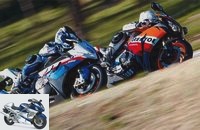
Comparison test athletes
BMW S 1000 RR against Honda Fireblade
S 1000 RR causes an uproar in the world of athletes. While the innovations of the Japanese manufacturers in recent years were limited to the asymmetrical firing order of the Yamaha YZF-R1 and above all the sports ABS of the Honda Fireblade, BMW has now opened a very large barrel. Racing ABS, traction control and a performance at the 200 hp barrier.
Which, in addition to enthusiasm, also raises questions: What do you get out of it in everyday life on the street? And that’s enough to put a harmonious and powerful overall package like the Fireblade in its place?
jkunstle.de
The Honda’s electronically controlled steering damper is in a class of its own.
The sun fights its pale orange over the horizon of southern France into the day, the thermometer hangs at a frosty four degrees. And the BMW growls immediately when the button is pressed. Also the Fireblade, still a 2009 model, with slightly increased idle throttle. The first few kilometers are characterized by carefully feeling the cool asphalt. The Bridgestone BT 015 "F." The Honda, especially the otherwise extremely adhesive Metzeler Racetech K3, want to be brought up to temperature before they can be felt perfectly. With cold engines, the lowest engine speeds and careful gas commands, it goes through the still quiet southern French villages towards the hinterland. While the Honda completes this warm-up phase smoothly and unobtrusively, the BMW follows it – no less well-behaved. It purrs gently behind the Honda at two to three thousand revolutions, no jerking, no choking. The gear changes are a bit resinous, but precise. Obviously, the engineers have not sacrificed everyday manners for the enormous top performance.
While the operation of throttle, clutch and gear shifts on the Honda, at least the throttle grip wants to be tackled much more tightly on the BMW. And its non-adjustable steering damper acts very tightly under these conditions at creep speed, which makes the BMW stagger a little below city speed. The electronically controlled steering damper of the Honda stays completely out of the way because it is not needed. But the day is still just beginning.
The temperatures of cooling water, tires and air are approaching the ideal values on the cornering paradise in the hinterland of Marseille. Anyone who would have expected the BMW to buy its horrific top performance with a poor idea in the middle speed range will quickly be taught otherwise. It handles short sprints or overtaking maneuvers just as confidently as the Honda. There is no hectic stirring in the gearbox in search of the right gear and the right speed. Pressure from the lower rev range is sufficient for a brisk country road speed. The Honda is perhaps a bit more researcher from the very bottom, but has a clear hang at 4000 rpm. The BMW, on the other hand, pulls through more evenly and hardly less full, while hanging clean on the gas. Even if not quite as promptly and directly as the Fireblade, which implements the gas commands even more quickly. There are advantages for the BMW in terms of load changes in the increasingly narrow winding curves.
jkunstle.de
Smart details such as the rear height that can be adjusted using an eccentric insert and the clearly legible numbered damping adjustment screws characterize the BMW.
So up to this point, the BMW is on par with the Honda, although it is uncompromisingly designed for sport, which is also reflected in the seating position: low handlebars, the pilot moved close to the steering head for optimal front wheel contact. The fact that the compact sitting posture does not degenerate into torture is thanks to the successful arrangement of pegs, bench and handlebars.
The handlebar stubs of the Honda are a little higher and more comfortable, only the slightly too high notches disturb the harmony a little. Nevertheless, their seating position is also suitable for relaxed speeding. But it quickly becomes clear that the BMW is by no means just the good newcomer and follower, but is seriously reaching for the crown in the superbikes.
Comparison test athletes part 2




11 photos
Pictures: Comparison test athletes
To home page
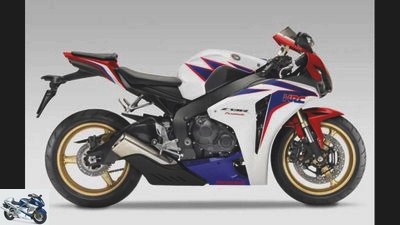
Honda
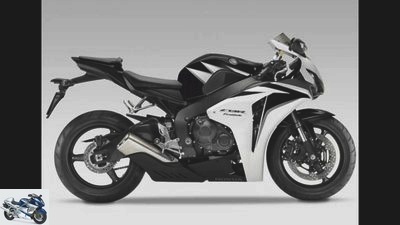
Honda
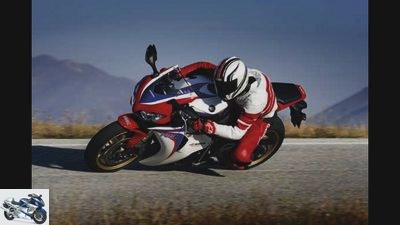
Honda

Honda
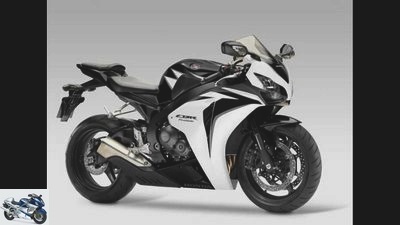
Honda
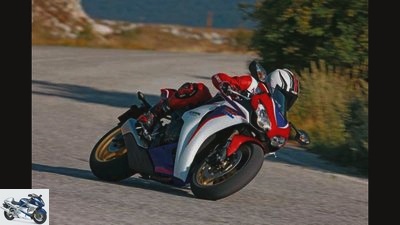
Honda
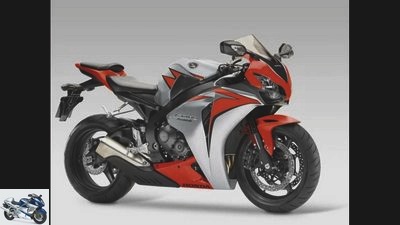
Honda
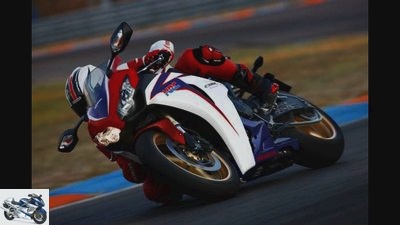
Honda
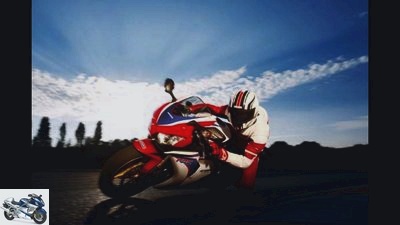
Honda

Honda
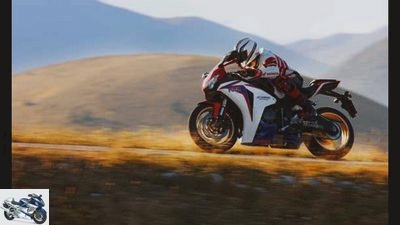
Honda
The Honda scores points with its ingenious electronically controlled steering damper, which keeps the front under control even on the worst of slopes. And in terms of handiness. The BMW moves at a high level with its pleasant handling, but the Honda turns in even more nimbly and wags more loosely over the asphalt even at higher speeds, while the BMW stiffens a bit from around 120 km / h.
Also different is the picture with the chassis tuning. The suspension elements of the Honda present themselves sufficiently tight, but always with comfort in mind. The BMW is trimmed more uncompromisingly in the direction of sport, the fork works a bit tighter without being uncomfortable, the shock absorber, on the other hand, cannot deny a healthy hardness on edges and joints, which is at the expense of comfort. But it brings impeccable stability in fast and undulating passages. The bottom line is that there is a stalemate in the chassis chapter.
jkunstle.de
The speedometer of the Honda is clear, but doesn’t offer a lot of information.
And the engines? When it comes to pulling through, the two units equipped with efficient slipping clutches, as already mentioned, do not give each other anything. It only becomes interesting when they are let off the leash. With measured 177 hp and the homogeneous power curve, especially between 5000 and 10000 rpm, the Fireblade goes off like the fire brigade. Thanks to the steady development of power, it never scares you with an attack-like punch, but delivers steady and relentless thrust. The BMW is different. Up to 8000 rpm only slightly weaker than the Honda, a volcano seems to explode under the driver at this speed. With a throaty outcry and a force previously unheard of from series machines, the BMW tears away from the fact that you should have all seven senses together.
However, you also have to realize that this kick is only available at around 80 km / h in the relatively short first gear, but then lasts up to around 140. In the second one has already left the socially acceptable speed range at these speeds. From which it follows that the Honda is by no means slower in everyday civilian life. In any case, BMW aficionados would like to warmly recommend traction control, which can be set in several stages like ABS. Not only because it is actually very effective in preventing major damage to the ground under adverse conditions. But also because it is a bit rustic, but at the same time efficiently tames the violent wheelie tendency.
jkunstle.de
In contrast to the Honda, the cockpit of the BMW can boast a lot of details and information.
The Honda driver has to do without this delicacy, but at the latest at the petrol pump he gets some satisfaction. The Fireblade burns its fuel extremely efficiently and on average consumes a whole liter less than the BMW, which gives it a significantly larger radius of action with practically the same tank content.
And its ABS only needs one setting, but allows the same deceleration at country road speed, controls more finely and keeps the motorcycle quieter (see box on page 30). In the end, that doesn’t change the fact that the air at the top of the Superbike is very thin and the hunted have now become hunters. And BMW increased to 2-0 in the brand duel.
Technical data BMW S 1000 RR
jkunstle.de
Even if the BMW tries to achieve optical independence with its shark gills and asymmetrical headlights, you have the feeling that you have seen it all before. But not with such a powerful engine, stowed away in such a good overall package.
Engine:
Water-cooled four-cylinder four-stroke in-line engine, two overhead, chain-driven camshafts, four valves per cylinder, rocker arm, wet sump lubrication, injection, Ø 48 mm, regulated catalytic converter, alternator 434 W, battery 12 V / 10 Ah, mechanically operated multi-disc oil bath clutch, (Anti -Hopping), six-speed gearbox, chain, secondary ratio 44:17.
Bore x stroke 80.0 x 49.7 mm
Displacement 999 cm3
Compression ratio 13.0: 1
rated capacity 142.0 kW (193 hp) at 13,000 rpm
Max. Torque 112 Nm at 9750 rpm
landing gear:
Bridge frame made of aluminum, upside-down fork, Ø 46 mm, steering damper, adjustable spring base, rebound and compression damping, two-arm swing arm made of aluminum, central spring strut with lever system, adjustable spring base, rebound and compression damping, double disc brake at the front, Ø 320 mm, four-piston fixed calipers , Rear disc brake, Ø 220 mm, single-piston floating caliper.
Cast aluminum wheels 3.50 x 17; 6.00 x 17
Tires 120/70 ZR 17; 190/55 ZR 17
Tires in the test Metzeler Racetec K3 Interact
Mass and weight:
Wheelbase 1432 mm, steering head angle 66.1 degrees, caster 96 mm, spring travel f / h 120/130 mm, seat height * 810 mm, weight with a full tank * 208 kg, load * 197 kg, tank capacity / reserve 17.5 / 4.0 liters.
Guarantee two years
Mobility guarantee two years
Service intervals 10000 km
Colours Silver, gray, green, white / red / blue
price 15,500 euros
Price test motorcycle ** 17 555 euros
Additional costs around 206 euros
* MOTORCYCLE measurement
** including ABS and DTC (1220 euros), automatic switch (360 euros) and special white / blue / red paintwork (475 euros)
Technical data Honda Fireblade
jkunstle.de
The move away from the underseat exhaust made possible the graceful rear end, which is strongly reminiscent of the MotoGP racers. In terms of workmanship, the Honda, like the BMW, is a really solid piece of large-scale motorcycle construction.
Engine:
Water-cooled four-cylinder four-stroke in-line engine, a balance shaft, two overhead, chain-driven camshafts, four valves per cylinder, bucket tappets, wet sump lubrication, injection, Ø 46 mm, regulated catalytic converter, 350 W alternator, 12 V / 7 Ah battery, mechanically operated multi-disc oil bath clutch , (Anti-hopping), six-speed gearbox, O-ring chain, secondary ratio 42:16.
Bore x stroke 76.0 x 55.1 mm
Cubic capacity 1000 cm3
Compression ratio 12.3: 1
rated capacity 130.7 kW (178 hp) at 12,000 rpm
Max. Torque 112 Nm at 8500 rpm
Landing gear:
Bridge frame made of aluminum, upside-down fork, Ø 43 mm, steering damper, adjustable spring base, rebound and compression damping, two-arm swing arm made of aluminum, central spring strut with lever system, adjustable spring base, rebound and compression damping, double disc brake at the front, Ø 320 mm, four-piston fixed calipers , Rear disc brake, Ø 220 mm, single-piston floating caliper.
Cast aluminum wheels 3.50 x 17; 6.00 x 17
Tires 120/70 ZR 17; 190/50 ZR 17
Tires in the test Bridgestone BT 015 “F”
Mass and weight:
Wheelbase 1410 mm, steering head angle 66.8 degrees, caster 96 mm, spring travel f / r 120/135 mm, seat height * 830 mm, weight with a full tank * 209 kg, payload * 170 kg, tank capacity / reserve 17.7 / 4.0 liters.
guarantee two years
Service intervals 6000 km
Colours Black, blue, red / white / blue, Repsol
price 14990 euros
Price test motorcycle ** 16490 euros
Additional costs around 170 euros
* MOTORCYCLE measurements
** including ABS (1000 euros) and special Repsol paintwork (500 euros)
Measurements
Drawing: archive
Power on the crankshaft. Measurements on Dynojet roller test stand 250, corrected according to 95/1 / EG, maximum possible deviation ± 5%.
Highs and lows: the BMW is more powerful up to 4000 rpm. At this speed, the full load curve reveals the Honda’s torque drop. Apart from this one trailer, their performance is extremely homogeneous. And outperforms the BMW between 5000 and 9000 rpm. What the S 1000 RR packs in performance from 10,000 rpm is unique for a street-legal 1000 cc.
Top speed
| Manufacturer | km / h |
| BMW | 299 |
| Honda | 293 |
acceleration
| Manufacturer | 0-100 km / h (in seconds) |
0-140 km / h (in seconds) | 0-200 km / h (in seconds) |
| BMW | 3.1 | 4.5 | 7.0 |
| Honda | 3.3 | 4.7 | 7.5 |
Draft
| Manufacturer | 60-100 km / h (in seconds) | 100-140 km / h (in seconds) | 140-180 km / h (in seconds) |
| BMW | 3.4 | 3.3 | 3.3 |
| Honda | 3.5 | 3.2 | 3.0 |
Fuel consumption (country road)
| Manufacturer | Liters / 100 km |
| BMW | 6.0 |
| Honda | 5.0 |
Theoretical range (country road)
| Manufacturer | kilometre |
| BMW | 292 |
| Honda | 354 |
Brake measurements
jkunstle.de
From 100 km / h only just ahead of the Honda, the BMW can decelerate significantly more from 200 km / h.
Smaller, lighter, more compact and modern ABS systems are becoming ever more powerful. While the Honda system adds a good ten kilograms of weight, the BMW is just 2.5. But unlike BMW, the Honda system, which cannot be switched off, is a fully electronic one. Brake-by-wire, which is why the driver doesn’t feel any pumping in the hand lever. Nevertheless, the developers have managed to provide the system with excellent feedback. In the BMW system, the brake pump and pressure modulator are connected to one another via the brake line. A slight pulsation can therefore be felt in the hand lever. Unlike the Honda, the BMW system can be switched off. And it has four different levels: Rain, Sport, Race and Slick. The last two are designed for use on the racetrack in such a way that they regulate much closer to the blocking limit and no longer offer any protection against the forward somersault.
The emergency: For the relevant braking measurements on country roads, i.e. from 100 km / h on non-slip asphalt and with a jump in the coefficient of friction – the braking section was interspersed with three sandy areas – the BMW was braked in sport mode. There is an exact tie between Honda and BMW. Only braked as a trial on a non-slip surface in the more aggressively tuned slick mode, the BMW comes to a halt 1.7 meters earlier from 100 km / h. However, there are differences in the control behavior, especially when braking over sand stains. While the BMW comes to a standstill with harder and coarser control processes and a lurching rear, the Honda remains on course with exemplary stability. At the transition from sand to asphalt, the BMW even lifted its buttocks. The picture looks completely different when braking from 200 km / h, which is supposed to simulate racing. Here the BMW in slick mode with 10.2 m / s² is clearly ahead of the Honda with 9.7 m / s². And comes to a stop just under eight meters in front of the Honda. Even if you don’t brake to a standstill on the racetrack, this testifies to the successful tuning of the BMW ABS for racing. For Honda pilots who visit the racetrack, an ABS that can be switched off might be desirable. In any case, both systems are a sensible investment.
Braking from 100 km / h
| delay | Braking distance | |
| BMW sport mode |
9.3 m / s² | 41.5 m |
| BMW slick mode |
9.7 m / s² | 39.8 m |
| Honda | 9.3 m / s² | 41.5 m |
Braking from 200 km / h
| delay | Braking distance | |
| BMW slick mode |
10.2 m / s² | 151.3 m |
| Honda | 9.7 m / s² | 159.1 m |
Braking with a jump in the coefficient of friction
| delay | Braking distance | |
| BMW sport mode |
8.1 m / s² | 47.6 m |
| Honda | 8.1 m / s² | 47.6 m |
Conclusion
jkunstle.de
The S 1000 RR and the Fireblade are almost on par, and not only here in the picture.
1st place: BMW S 1000 RR
Even if BMW had good templates with the Japanese’s many years of development work – beating them as a newcomer on their own territory deserves respect.
2nd place: Honda Fireblade
Second place, first loser? Not quite. The Fireblade is still an excellent bike that just had to bow to an even better one.
Drawing: archive
Scoring engine
The BMW offers better performance, the four in a row simply pushes ahead powerfully. The certainly not weak Honda four has to bow to this. Even if the Fireblade has the more direct throttle response and the more slippery gearshift, the engine chapter just goes to the BMW, which also has less pronounced load change reactions in sport mode and completes the cold start a little more smoothly.
Winner engine: BMW
Drawing: archive
Scoring undercarriage
It can not be excluded, that the Honda would have scored more points with other tires in terms of handling and steering behavior. In any case, BMW benefits from their Metzeler rubbers in this regard. While the BMW relies on a sporty, taut chassis set-up that ensures a lot of stability, the Honda has a much stronger focus on suspension comfort. The feedback from both of them has been fantastic. Makes a draw in this category in the end.
Winner Wagon: Tie
Drawing: archive
Scoring everyday
Even if the ergonomics the BMW, with its handlebar stubs, which are clamped a little lower, is more geared towards sport, the handlebars, pegs and seat are arranged a little more harmoniously than with the Honda. Ultimately, the richer equipment of the BMW and somewhat more practical handling details such as checking the oil level via the sight glass decide this chapter for Bavaria.
Winner everyday life: BMW
Drawing: archive
Scoring security
Here the Honda turns the tables. The decisive factor is its superior steering damper and ABS, which also enable excellent deceleration, but at the same time ensure more stability when braking hard. In addition, their stoppers can be dosed a little finer.
Safety winner: Honda
Drawing: archive
Scoring costs
Two year guarantee the Honda provides the BMW with a two-year warranty and a mobility guarantee. The BMW has longer service intervals for this. The winner at the pump is the Honda.
Winner costs: BMW
| maximum | BMW | Honda | |
| Overall rating | 1000 | 703 | 693 |
| placement | 1. | 2. | |
| Price-performance note | Top grade 1.0 | 2.7 | 2.5 |
Price-performance winner: Honda
BMW’s point lead is not enough to offset the additional costs of traction control
Price comparison of the BMW S 1000 RR and Honda Fireblade
Used BMW S 1000 RR and Honda Fireblade in Germany
The high-quality components and great driving characteristics of the BMW S 1000 RR and Honda Fireblade remain, but the price-performance ratio is once again mixed vigorously on the used motorcycle market. There you can find both the BMW S1000RR and the Honda Fireblade in good condition at low prices: used BMW S 1000 RR and Honda Fireblade in Germany
Related articles
-
Comparison test Honda Fireblade, VTR 1000 SP-2
Artist Comparison test Honda Fireblade, VTR 1000 SP-2 Everything stays different Honda is the only motorcycle manufacturer to build two 1000cc super…
-
fact Top test Honda Varadero 1000 Pleasure ship Truly a monumental motorcycle, weighing 267 kilograms, as high as a cathedral, comfortable and fast. In…
-
Comparative test of athletes against naked bikes
fact Comparison test of athletes against naked bikes Family twist: athletes versus naked bikes They come from one family and yet they are worlds apart….
-
Honda CBR 1000 RR Fireblade 2012
Honda 16 photos Youtube 1/16 Honda CBR 1000 RR Fireblade 2012 Youtube 2/16 Honda CBR 1000 RR Fireblade 2012 Youtube 3/16 Honda CBR 1000 RR Fireblade 2012…
-
BMW F 800 GT, Kawasaki Z 1000 SX and Honda VFR 800 F in the test
fact 44 photos fact 1/44 fact 2/44 fact 3/44 fact 4/44 fact 5/44 In praise of diversity: the three test candidates all want the same thing, but try to…
-
Jahn comparison test of supersports: Ducati 998, Honda Fireblade, Kawasaki ZX-9R, Suzuki GSX-R 1000, Triumph Daytona 955i Centennial The K-Question Five …
-
Honda Fireblade vs. Suzuki GSX-R 1000 in comparison test
Maccabelli The last four-cylinder without control electronics Test: Honda Fireblade against Suzuki GSX-R 1000 Content of They are the last current…
-
Comparative test of Italian athletes
Artist Comparison test Italo-Sportler, Aprilia RSV 1000 R Factory, Benelli Tornado Tre 1130, Ducati 999 S, MV Agusta F4 1000 R Squadra Azzurra They…
-
Honda Crossrunner and Suzuki V-Strom 1000 in comparison test
fact 30th photos markus-jahn.com 1/30 Honda Crossrunner and Suzuki V-Strom 1000 in comparison test. markus-jahn.com 2/30 Honda Crossrunner and Suzuki…
-
Gargolov Top test Honda VTR 1000 F SILENT STAR The VTR 1000 F prefers to leave appearances in the glaring limelight to others, instead promising…